How does art affect humanity and human rights? Does it play an important role in human rights advocacy? Throughout history, people have used the arts as a form of self-expression by reflecting on their lives and what they observe. Art and design are constantly changing, and growing, with history. It is constantly being influenced while influencing societal events. As an artist and graphic designer, I believe that use of imagery influences societies, helping raise awareness of social and political issues. In the vast world of social and political arts, there are a few examples of work that stood out to me because of their contribution to society, namely: “The Hand That Will Rule the World” by Ralph Chaplin, “All Power to the People” by Emory Douglas, “The Anatomically Correct Oscar” by The Guerilla Girls, “Red Sand Project” by Molly Gochman, “The Blue Bra” by Bahia Shehab, and “America” by Touba Alipour. These are a few good examples of how art and design can impact human rights with solidarity, awareness, and protest.
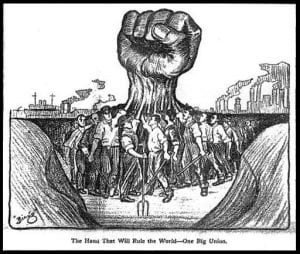
The symbol of the clinched fist has been a symbol of solidarity as early as 1917. “The Hand That Will Rule the World” by Ralph Chaplin is an illustration referring to the IWW (Industrial Workers of The World). Industrial unionism began when skilled workers were displaced by modern machinery and the monopolization of industries. It was a union that believed industries should be controlled by the workers, benefiting the many instead of enriching the few, and create better working conditions. In this image, the workers are uniting their arms and creating one giant fist, which represents solidarity and unity, while holding tools, representing manuallabor, while factories in the backdrop symbolize the machinery displacing the workers.
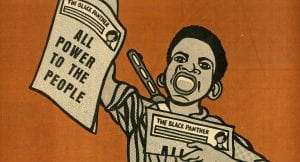
The Black Panther Party was an African-American organization founded October 15, 1966 in Oakland, CA. One of their greatest successes was using imagery to reach people across the country about their movement. According to The New York Times, even though the Black Panther Party was associated with armed resistance, their most powerful weapon was reaching out to African-American communities through works of art. Emory Douglass, the artist behind many these images, has a background in printmaking and activism, pushing him to create images that show the injustice toward communities of color in the United States. His illustration “All Power to the People” is another example of the solidarity symbolism employed by the raised fist. The raised fist and the words “All Power to The People” brings a sense of unity to the viewer. Also, the person’s expression speaks on an emotional level, as if they’re shouting these words, making it a very powerful piece of artwork.

The Guerilla Girls are feminist activist group comprised of more than 55 artists. They describe themselves by saying: “We wear gorilla masks in public and use facts, humor and outrageous visuals to expose gender and ethnic bias as well as corruption in politics, art, film, and pop culture. We undermine the idea of a mainstream narrative by revealing the understory, the subtext, the overlooked, and the downright unfair.” This group of activist artists started in 1985 and, by the early-21st century, have expanded their awareness into the media world, namely the film industry. “The Anatomically Correct Oscar” brings awareness to the racism and sexism in the film industry by portraying a white male holding his genitals with text boxes demonstrating the percentage of people of color that have won Oscars in the past 86 years. The Guerilla Girls displayed this billboard in Hollywood a few months leading up to 2016 Oscars, noting, “the people we want to reach will see it…There is so much positive press around the Oscars – the gowns, the stars – that we decided it was time for another point of view.”
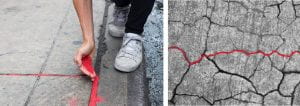
Molly Gochman’s “Red Sand Project” is a worldwide instillation that takes a hands-on approach of bringing awareness to human trafficking. This project encourages all communities to pour red sand into cracks on sidewalks to recognize the overlooked populations (refugees, immigrants, girls, and others) that are at risk of slavery and exploitation. “These interventions remind us that we can’t merely walk over the most marginalized people in our communities — those who fall through the metaphoric cracks”, explains Molly Gochman. This informative, and largely interactive, work of art takes simple, yet powerful, gestures and to bring worldwide awareness through photography and social media. It is an ongoing project, raising action for those who are overlooked and vulnerable to human trafficking.
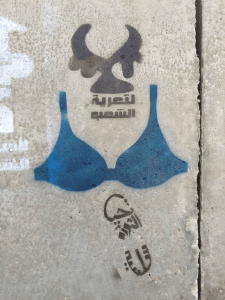
In 2011, various outbursts of popular protests swept the Middle East and North Africa, causing a revolutionary wave called the Arab Spring. Staring from Tunisia and later spreading to Egypt, Yemen, Bahrain, Libya, and Syria, people were rising against their oppressive leaders. As the protests grew larger they were met with violent responses from authorities. One of the striking things that came out of this short period was the growth in street art, graffiti, and calligraphy. “The Blue Bra” by Bahia Shehab, located in Cairo, Egypt, is a great example of protest of oppression. This graffiti is part of an instillation called “Thousand Times No” which Shehab explains, “represents a rejection of both the conformity and the repression that often stifle the Arabic speaking region and Islamic cultures.” The text above the Blue Bra is saying “no stripping the people” and the sole of the military boot reads “long live a peaceful revolution”, calling the incident of a veiled girl who was stripped and beaten by police on December 18, 2011, and happened to be wearing a blue bra. In another location, Sheab installed a calligraphic graffiti which is an Arabic translation of Pablo Neruda’s quote, “you may crush the flowers, but you cannot delay the spring”.
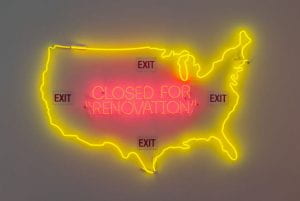
Touba Alipour’s “America” is a mixed media artwork, curated by gallery director and artist Indria Cesarine, placed in The Untitled Space gallery’s “ONE YEAR OF RESISTANCE” exhibition in January 2017, shortly after the election of U.S. President Donald Trump. This exhibition, which included over 80 artists, addressed and protested policies that challenged human rights in our society such as immigration rights, health care, reproductive rights, climate change, transgender rights, white supremacy, gender equality, gun control, sexual harassment and many others. Among these artists, Touba Alipour addressed the travel bans placed by Trump which prevented people from six Muslim countries to enter the United States. “Being from Iran, it definitely affected me in different ways”, mentions Alipour, “I’ve seen families being torn apart, and they had green cards, they were living here, they just went to travel, and when they came back they were told they can no longer enter the country”.
Art is a way for people to express themselves, whether for the sake of imagination or to express ideas. It has been used effectively today, and throughout history, to send public messages about social and political issues. Human rights and the arts go together because of the expressive nature of both subjects. As people, we can stand up for our rights through expression. Due to their ability to create visual interest and to promote solidarity, awareness, and protest, artists and designers play a pivotal role in society by promoting human rights advocacy. Especially in the modern age, where people rely heavily on technology and media, it is important to send messages that work toward creating a society that respects human rights for themselves as well as others.
